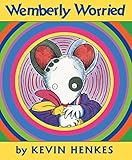Lesson 1: Reasonable Predictions
Lesson Plan
Wemberly Worried | 170L

- Learning Goal
- Make reasonable predictions for the outcome of a story.
- Duration
- Approximately 50 minutes
- Necessary Materials
- Provided: Example Chart, Independent Practice Worksheet
Not Provided: Wemberly Worried by Kevin Henkes, chart paper, markers
-
Activation & Motivation
Activate prior knowledge by modeling real-life realistic and unrealistic predictions. For example, if I ask Robert to turn on the lights, I think that he will cry. Is this realistic?
-
Teacher Modeling

will explain that when good readers read or listen to a story, they make predictions (or guesses) about what will happen next in the story. It is helpful for predictions to be reasonable, or make sense. I will explain the meaning of reasonable predictions (guessing what will probably happen next). I will model making a reasonable prediction about what will happen in Wemberly Worried by Kevin Henkes, based on the cover of the book. By reading the title and looking at the pictures on the cover, I can predict that the book will probably be about a little mouse that worries. I would not predict that it would be about a pig or other animal because there isn’t anything on the cover to tell me that. I am using the pictures and text to make a reasonable prediction. I will begin reading Wemberly Worried, stopping after the author says that Wemberly worried about “big things, small things, and everything in between”. I will predict what Wemberly will worry about in the story and how these worries may affect her. For example, I may predict that Wemberly will worry about monsters in her closet. Maybe Wemberly won’t be able to sleep alone at night.
-
Think Check
Ask: "What is the best way to make predictions?" Students should respond that they should read the text, stop and make a guess about what may happen next based on what would make sense.
-
Guided Practice

will continue to read Wemberly Worried up to the page where Wemberly worries about rubbing Petal’s ears off. I will explain that the next page is about Wemberly’s birthday. We will make predictions about what will happen next at Wemberly’s birthday. We will discuss whether or not the predictions are reasonable. We will continue reading up to the page about the start of school. We will identify reasonable predictions and unreasonable predictions on a chart. (Example is provided.)
TIP: When students make unreasonable predictions, explain why the prediction is unreasonable. It’s not essential that students’ predictions are correct, but they should be possible for the story.
-
Independent Practice

will continue to listen to Wemberly Worried up to the page where Wemberly and Jewel meet. You will draw a picture and write a reasonable prediction of what will happen after Wemberly and Jewel meet. (Independent Practice Worksheet is provided.) Note: After students complete the Independent Practice Worksheet, have the class come back together and read the end of the book aloud.
TIP: Differentiate the Independent Practice by providing students with possible picture predictions from which to choose.
Texts & Materials
Standards Alignment
(To see all of the ReadWorks lessons aligned to your standards, click here.)



Thanks for this resource. My new pupils will enjoy this activity.
I like the lesson. I plan on using it as a review lesson for my new second graders. It will also serve as an assessment on can they make reasonable predictions before I move deeper into predicting, confirming and modifying predictions.
Very thorough. Great way to look at prediction for reading.
I really liked this lesson